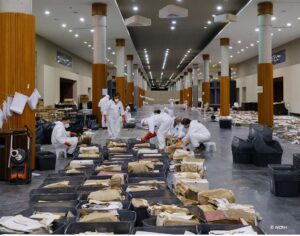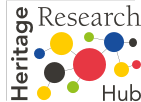The impressive chronicle by Gemma María Contreras Zamorano, Director of the Institut Valencià de Conservació, Restauració I Investigació, Spain of the first interventions on movable heritage, archives in particular, carried out by specialised interdisciplinary teams in response to the terrible floods that hit Valencia on 29 October 2024.
On 29 October 2024, a catastrophic DANA (Depresión Aislada en Niveles Altos, or Isolated Depression at High Levels) struck the province of Valencia, unleashing unprecedented flooding that devastated countless municipalities. DANA is a meteorological phenomenon that occurs when cold air collides with warmer air masses, leading to intense storms. In some villages near the ravines, muddy waters rose to nearly four metres, leaving behind a trail of destruction that affected homes, infrastructure, and invaluable cultural heritage. This disaster called for a swift and coordinated response to assess the damage and initiate urgent preservation efforts, especially for cultural assets, archives, and artworks critical to the region’s identity and history.
Although during the first few days the population flocked on foot to help people clean their houses, as soon as the damaged areas became accessible, the Regional Ministry of Education, Culture, Universities and Employment of the Generalitat Valenciana, through the Regional Secretariat of Culture, began a campaign of inspection and monitoring of all the affected areas, with special emphasis on the damaged movable assets, while at the same time scouting for an evacuation area in cases of extreme need.
For this inspection work, multidisciplinary teams of conservators, restorers, librarians, archivists and archaeologists were set up to visit the different disaster areas and assess the extent of the damage and establish priorities for immediate intervention. Following the instructions of the security forces, who were still focused on searching and rescuing missing persons in the most impacted areas, the inspections started in least affected municipalities
Consequently, the most highly qualified cultural heritage technical experts, including the team of restorers from the Institut Valencià de Conservació, Restauració I Investigació (IVCR+i), travelled to towns such as Picanya, Alfafar and Paiporta, so as not to inhibit the most urgent priority rescue work.
Based on the information collected from this preliminary work, on-site action teams were established, giving preference to seriously affected art storage facilities, some churches and, particularly municipal archives which, due to the nature of the organic materials that make up their collections, had suffered most from the consequences of water infiltration and mud.
Technical experts operating on site carefully unpacked the pictorial and sculptural works, removing the storage boxes that had deteriorated due to microbial infestation. After the removal of their packaging, damaged artworks were superficially cleaned of the mud and sprayed with a hydroalcoholic solution before being transferred to the designated warehouses intended exclusively for their reception.
During this first phase, a detailed sheet of each work was drawn up while, subsequently, assessing the need and appropriateness, in order of priority, of the overall restoration of the damaged works.
As per the municipal archives, the picture was bleak. Most of the archives we visited were located on the ground floor and basement spaces. The force of the water busted the metal doors damaging also the piles of documents inside, so that access to these areas in the first few days was only possible with the help of firemen who could ensure the inspectors’ safe passage.
It is very difficult to describe the feeling of loss and sadness experienced as we entered the spaces covered in mud up to our knees, surrounded by huge volumes of books and documents soaked in mud, and were confronted with a proliferation of microorganisms spread all over the walls and on the assets themselves that increased with each visit.
In addition, many of those responsible for these archives had personally suffered the consequences of this terrible flood, and we were the ones in charge of reporting the state in which we found the fruit of their meticulous work of decades. Emotionally it was also difficult to come to terms with so much tragedy, both personally and professionally.
Once this first phase was over, we planned to gather all the documents and archive books, but we soon realized that the six thousand square metres of space made available by Feria Valencia needed to be increased to ten thousand, before starting the rescue work. It would have been literally impossible to carry out the job in the municipal archives, many of which still buried under layers of mud for several weeks.
It was at this point, when the scale of the emergency in the municipal, judicial and parish archives demanded effective action, that the Ministry of Culture was urged to activate the National Plan for Emergencies and Risk Management in Cultural Heritage.
Thus, two and a half weeks after the catastrophe, IVCR+i technicians, restorers from the Archivo del Reino of Valencia, technicians from the archives service of the General Directorate of Culture and restorers from all over Spain working for the Ministry of Culture, researchers from the Pablo de Olavide University, university volunteers and others, joined forces to begin the rescue of the books and documents.
At first, we collected the documentation ourselves until the Valencia Provincial Council, the Autonomous Police and the Army, through the Military Emergency Unit, were able to join in the transfer operations.
The space of the Feria Valencia was deemed appropriate for this purpose, not only because of its size, but also for the ease of access and height of the ceilings, among many other advantages. Once in there the documentation in muddy cases was distributed. Each of the containers was then eliminated, as well as other superfluous items such as folders or plastic bags. Finally, with the help of fans, we were able to ensure the proper ventilation.
Despite the constant support of the Generalitat Valenciana and the Ministry of Culture, the scarcity of material in the early days offered few treatment options, until the incorporation of two apparently simple techniques which produced satisfactory results. Firstly, the stacks of completely soaked documentation were separated by means of egg cups which, although it may seem incredible, not only support the weight without deforming, but are also humidity repellent. Afterwards, as the moisture was gradually removed, the possibility arose of making these piles smaller by incorporating blotting paper or other thin, unbonded paper to absorb the humidity, allowing for changes to be made. However, due to the size of the collections, this process was not as swift as we had initially hoped for. The drying phase is currently underway and will continue for a few more months.
In addition, we had two vacuum packaging machines in which we introduced the documentation with drying agents to accelerate the process. Although it is too early to draw any conclusions, this is proving to be the most effective method for ongoing drying processes with the first major moisture removed and in the final stage, after the vacuum-packing of each volume, the smoothing by air ventilation of the deformed bindings by the initial drying process.
As more materials become available, traditional drying with absorbent papers, woods and weights are being used, it is still impossible to reach all the books and documents present there. The next phase, once the documentation is dry, consists of the vacuuming of all these deposit areas, to remove the proliferation of microorganisms clearly visible on the surface. In fact, the Faculty of Biological Sciences of the University of Valencia is conducting a study to determine the species that have proliferated as a result of the flood, using advanced DNA techniques. We consider this to be a unique opportunity to determine the behaviour of these beings in exceptional circumstances.
The primary objective in this process is to be able to save the information in these volumes, bundles and sheets.
The second stage, which we will consider later, involves the restoration work proposed on the most valuable documentation which coincides with the oldest series of judicial and parish archives, and the single archive of the Federation of Rice Farmers’ Unions of Spain, owned by the Alfafar Town Council.
Special thanks go to the Valencian Association of Archivists, for completing the work with a specialised approach and assisting local archivists to prioritise the most important documentation to be rescued.
The town of Picanya, one of the most affected, has its church on the banks of the Poyo ravine. The water reached a height of 3.80 metres, the images were displaced from their usual location and the muddy water caused severe damage to the altarpieces in the side chapels, as well as the parish archives. The first days after the catastrophe, numerous volunteers worked with the local citizens to clean the church and remove the images and books. However, the level of humidity reached and the mud residues inside the structures of the retablos caused the microorganisms that are usually present in the environment to develop and proliferate on their surface to an extent that we had never observed before. This church had to be closed at the request of the inspectors who visited it, to avoid any risk to the people gathering there.
The first action we undertook was to open the lower areas of the altarpieces in order to ventilate them and, we are pleased to affirm that, despite the amount of mud deposited, the mud has dried and the microorganisms have decreased. However, while awaiting the support of the Military Emergency Unit, we intend to vacuum and disinfect the surface of all of them to allow the return of parishioners to their gathering place of worship and symbol of the town.
We had to rescue one of the images that had been locked in its niche, but which is now in a safe place and in a ventilated area that will undoubtedly improve its state of conservation. There is still the balance of all the assets that, although stabilised, require an in-depth restoration process. In this regard, it should be mentioned that the usual priority of interventions will not be set by the historical-artistic importance of each piece, but by the value attributed by their communities to these assets.
The task is titanic, but with enthusiasm and shared effort, we will surely be able to reach a wide range of movable assets. I would especially like to congratulate the curators of these assets who have overcome personal tragedies without neglecting the common good, the technicians who have gone out of their way to participate in the initial rescue operations under deplorable conditions, and the Administrations who daily value and support the joint work of recovery.
Experts and authorities are currently working to address this emergency. Lessons learnt together with further technical and operational details for overcoming it will be provided in the 5th issue of the PROCULTHER-NET Technical Bulletin, due to be published in July 2025.
Find #ProcultherNet on socials or visit PROCULTHER-NET webpage

